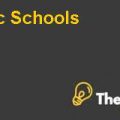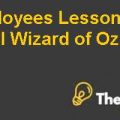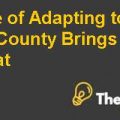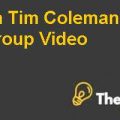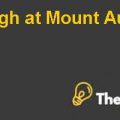Starbucks Case Study Solution
Problems statement
Starbucks has seen substantial sales growth over the last eleven years in terms of a consistant increase in retail sales suggesting that the brand has both brand loyalty and incremental sales. A brand which seems to be unaffected by recession still faces challenges in the area of customer satisfaction and has become the ultimate point of concern for the company’s executive management especially when the competitive environment has become rather challenging.
External Analysis
The following analysis looks at the external environment of Starbucks to see the industry rivalry before examining the company’s internal position.
Porter’s Five Forces Analysis for Coffee Retailers
The coffee retail market can be identified as one with intense competitive rivalry. This is because each of the medium sized coffee retailers has a vast network of retail stores spread globally. For instance, Starbucks competes against a variety of specialty coffee chains which are regionally concentrated in the United States. The challenge faced by each of these retail outlets is not only in terms of acquiring market share but also to have its own distinct competitive advantage since each of the brands tries to differentiate itself in some aspect.
The bargaining power of the buyer is high especially as he can have access to the product in all of these specialty stores offering coffee. In addition to competition against one another’s brand, they have retail outlets of their own brand in close proximity so ensuring customer loyalty in terms of offering an experience that would make a customer come back to a particular store which would need more than just coffee itself. This is why factors like service delivery are important for Starbucks as this differentiation could lead to a higher bargaining power for the seller. The seller has a low bargaining power if it lacks differentiation or is unable to attain brand loyalty.
The threat of substitute is low although beverages like Tea and Hot chocolate would also be direct substitutes for coffee. These specialty retail coffee shops try to have various beverages under their roof in order to lower the threat of substitutes from other retailers. However, assuming that these are not direct substitutes of one’s preferred coffee, the threat of substitutes is low. The threat of new entry in the coffee retail market is high given the fact that a new brand can even operate as a single store. A summary of the analysis can be seen in appendix4.
Internal Analysis
The internal analysis for Starbucks has been done using frameworks such as a SWOT analysis, VIRO analysis, Value chain Analysis, Ansoff’s Matrix for growth and Ratio Analysis. Each of these frameworks will help to identify the areas, which need to be prioritized in order to attain a competitive edge for Starbucks given its current competitive environment.
Starbucks Harvard Case Solution & Analysis
SWOT Analysis for Starbucks
The strengths, weaknesses, opportunities and threats for Starbucks have been identified below and a summary of this section can be seen in appendix 1.
Strengths: A company with rising profitability and a product which has shown a low income elasticity, Starbucks has core competencies in the form of great retail service and great tasting coffee sold across the globe. Strengths like low employee turnover and low-marketing expenses, backed by an incremental financial growth indicates that the company is financially sound to spend on areas, which need to be prioritized at this point.
Weaknesses: There are certain areas of weakness as well since the current customer reviews show that service delivery has not met the expected standards at Starbucks. Labor is already a large expense at Starbucks and investing more towards this area would increase operating costs. Starbucks’ own strategy of customer satisfaction through customization is leading to longer queuing times while at the same time its market penetration strategy of opening more retail outlets in areas of high wage rates is a source of increasing labor costs.
Opportunities: Opportunities exist in the form of a large growing coffee market in the USA with one third of coffee drinkers preferring to have coffee outside their homes. There is a vast room for expansion especially as the market is still in growth stage and there are prospects of expansion even in USA where eight states are still without any Starbucks operated retail outlets.
Threats: External factors like competitors, economic downturns and low barriers to entry in the coffee retail market can pose challenges for Starbucks unless it has a well-defined strategy to deal with them.
VRIO Analysis of Value Proposition
Starbucks is focused on creating an experience rather than just selling a product .The core competencies of Starbucks would be evaluated as per the VRIO framework (Jay B. Barney, 2010) (appendix 2) to understand whether the company’s competitive advantage or value preposition offers a potential long term competitive advantage or not. Starbucks’s value proposition is a combination of its product, service and atmosphere. For maintaining a competitive edge over its product, it controls the supply chain in terms of having a close check on the coffee growers, distribution of coffee and retailing of the product. While the coffee itself may be easily imitable and may not be rare on its own, the fact that Starbucks has a control over the organization’s supply chain, which makes this a source of competitive advantage, which can offer a sustainable long-term competitive edge over other small retail brands...........................
This is just a sample partial case solution. Please place the order on the website to order your own originally done case solution.

